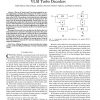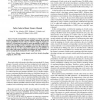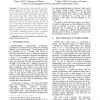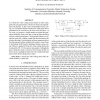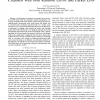105
click to vote
GLOBECOM
2010
IEEE
14 years 10 months ago
2010
IEEE
1 Shannon's channel capacity specifies the upper bound on the amount of bits per channel use. In this paper, we explicitly demonstrate that twin-component turbo codes suffer f...
TVLSI
2002
15 years 2 days ago
2002
Abstract--The use of "turbo codes" has been proposed for several applications, including the development of wireless systems, where highly reliable transmission is requir...
TIT
2002
15 years 2 days ago
2002
This paper is devoted to a Shannon-theoretic study of turbo codes. We prove that ensembles of parallel and serial turbo codes are "good" in the following sense. For a tur...
136
Voted
ETT
2000
15 years 7 days ago
2000
The input-output weight enumeration (distribution) function of the ensemble of serially concatenated turbo codes is derived, where the ensemble is generated by a uniform choice ov...
96
Voted
TIT
2008
15 years 10 days ago
2008
In this correspondence, the stopping set of turbo codes with iterative decoding in the binary erasure channel is defined. Block and bit erasure probabilities of turbo codes are stu...
114
click to vote
ADT
2005
15 years 10 days ago
2005
: The main problem concerning the hardware implementation of turbo codes is the lack of parallelism in the MAP-based decoding algorithm. This paper proposes to overcome this proble...
117
Voted
CORR
2008
Springer
15 years 15 days ago
2008
Springer
This paper provides an explicit expression for the capacity region of the two-user broadcast Z channel and proves that the optimal boundary can be achieved by independent encoding...
103
click to vote
ISLPED
1998
ACM
15 years 4 months ago
1998
ACM
CT This paper investigates the low power implementation issues of the soft-output Viterbi algorithm (SOVA), a building block for turbo codes. By briefly explaining the theory of t...
119
Voted
ICMCS
2007
IEEE
15 years 6 months ago
2007
IEEE
In a Wyner-Ziv video coding system based on turbo codes, parity bits are generated for a Wyner-Ziv frame and transmitted to the decoder. In this context of distributed source codi...
114
click to vote
ICC
2007
IEEE
15 years 6 months ago
2007
IEEE
Abstract— In this paper, we propose an unequal error protection (UEP) framework for progressive image transmission over wireless networks with both random errors and packet loss....

